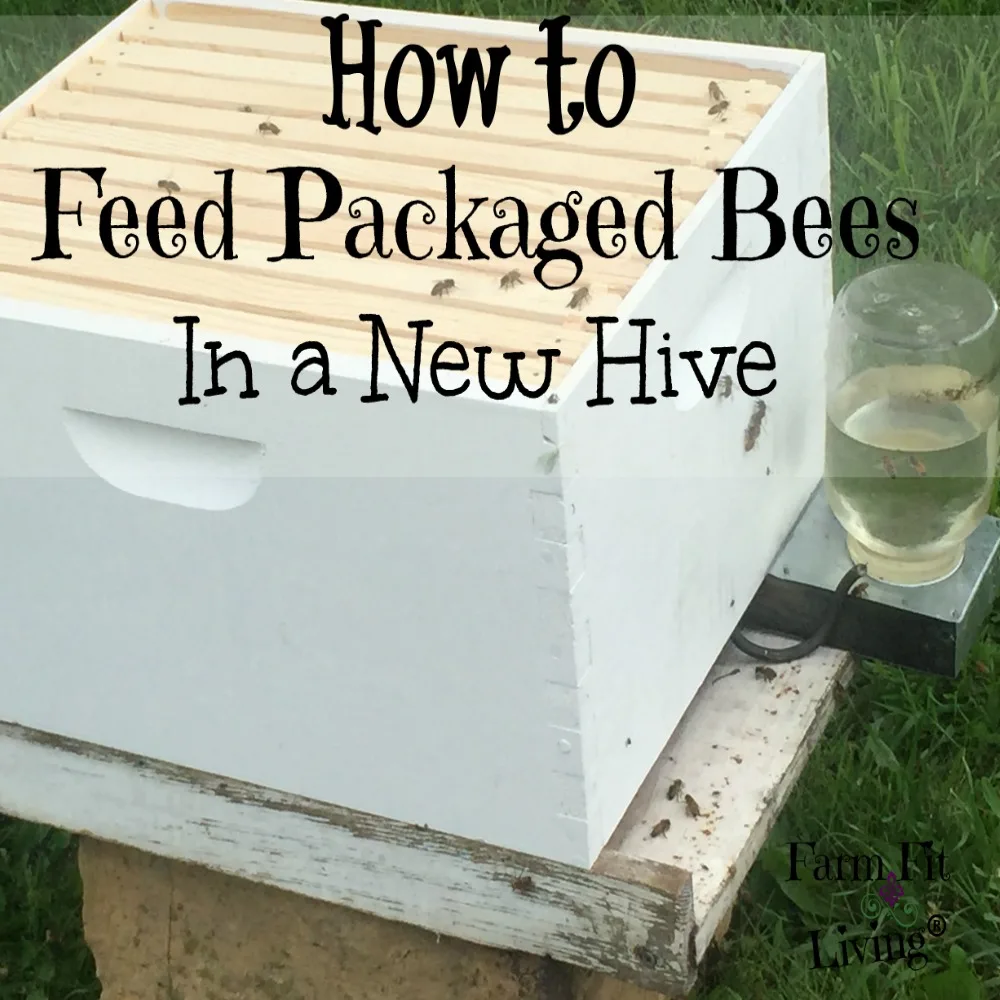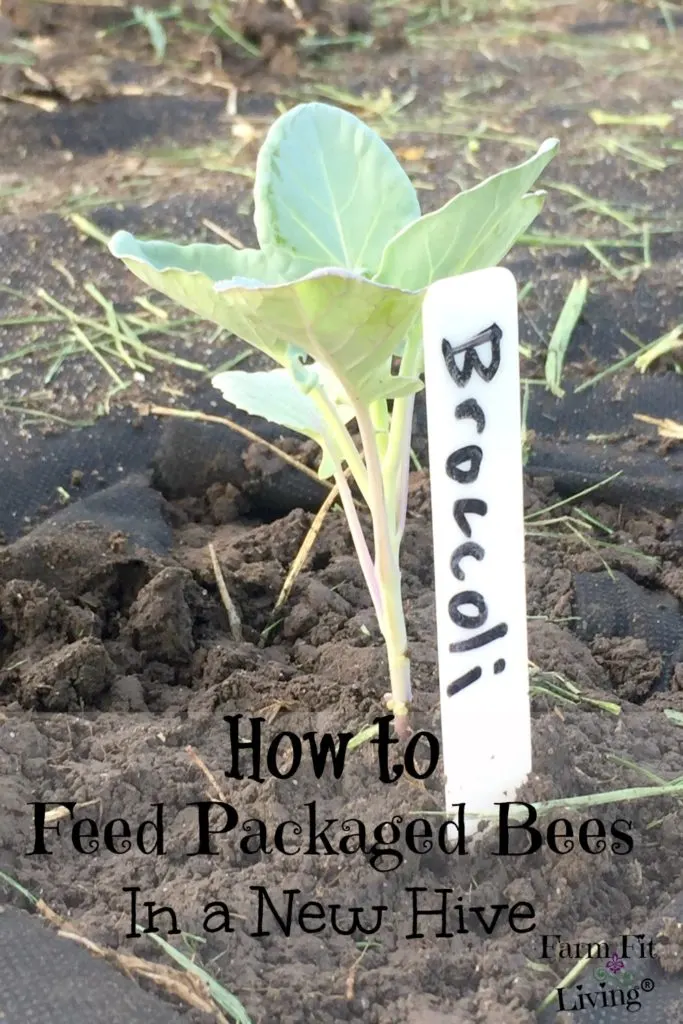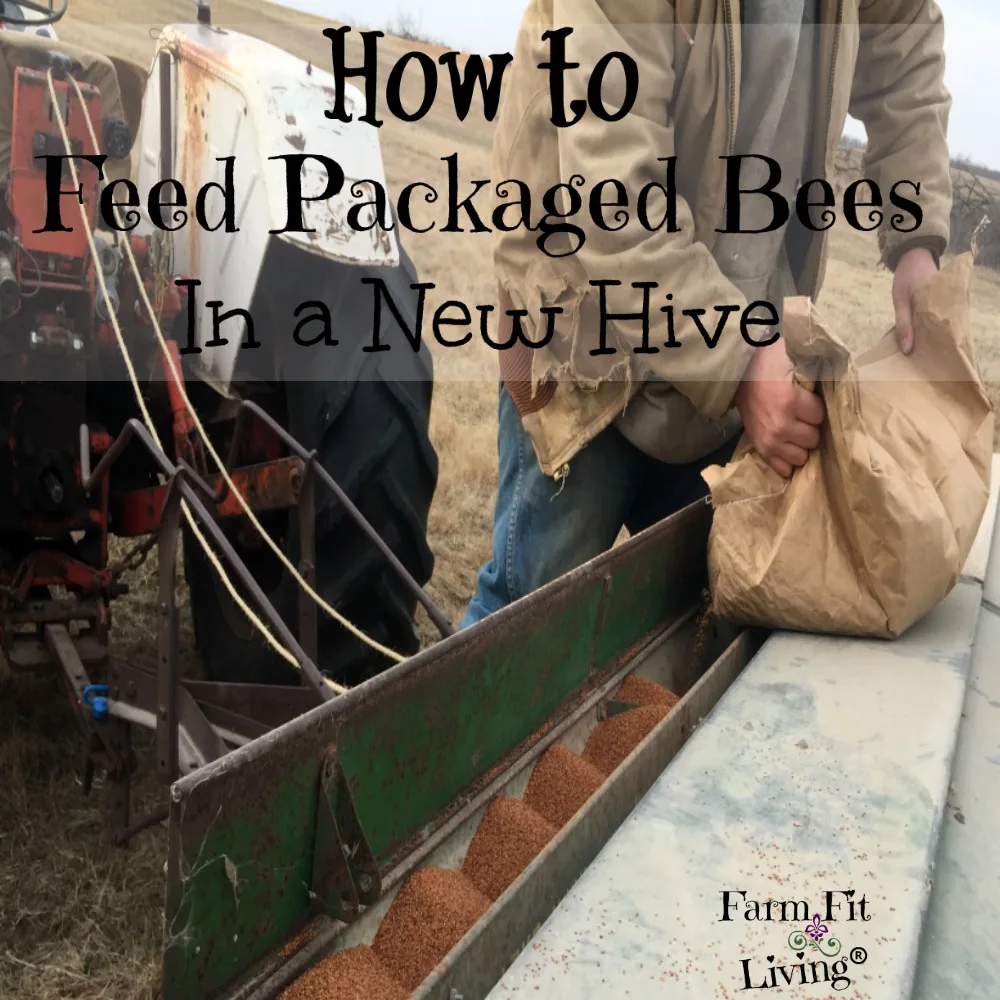Did you ever consider the fact that you would have to feed packaged bees installed into a new hive?
Feed packaged bees to help them stay nourished while they are building their reserves. They will be of no use and will have little productivity if they are underfed. They may even leave the hive!
Wow, I’m sure glad I prepared myself for this fact before I received my first round of packaged bees. My husband even laughed at the fact that we were gaining “bee chores” to add to our daily list of livestock chores.
Because, that’s what bees are. Little livestock. They need a little loving care from the beekeeper until they adapt to their new surroundings. The main reason to feed packaged bees from the moment they are installed is because they don’t have much or maybe even anything to eat in the new hive.
Like livestock, packaged bees need nourishment for the work and energy they are exerting. Feed them sugary supplement they will love. Plant flowers and plants that attract them to ingredients they need to prepare that nourishing food.
Think Local
There are numerous ways to feed bees so they will thrive in their new hives. I have listed a few ways I use or plan on trying in my first year of beekeeping.
Keep in mind that these methods I discuss below are specific to my area of the world. I live in Kansas, which has a very changeable and temperate climate. I never know what weather the next day will bring, so I like to be prepared and offer a variety.
To know what methods of feeding bees work best in your area, ask your mentor or fellow beekeeping group.
Most of them will tell you to incorporate sugar water as the bees’ first food.
Sugar Water
An easy first food for packaged bees is a 1:1 mixture of sugar water. For example: 1 cup sugar to 1 cup water. Mix it all together and you have a sweet and delicious syrup bees go crazy for.
In the first week, I filled my mason jar entrance feeders in each hive with sugar water every 2-3 days. With no honey reserves in a new hive, they have to build their own. It takes time.
Rome wasn’t built in a day. The bees are mystifying but they aren’t magical. The honey pot will take months to build and a year to produce an oversupply for you and me.
So, keep the containers full until the bees make enough honey to sustain themselves.
Pollen Patties
Many beekeepers place pollen patties inside the hives to feed packaged bees. This works well when there is low pollen counts available.
You can purchase pollen patties or make your own.
I plan to explore recipes to make my own pollen patties. If you have a great recipe, please share it with me in the comments!
Candy Canes
Yes. I know seasoned beekeepers who use candy canes to feed their bees. It’s a practice for cooler environments or if sugar water isn’t available.
They simply break some apart into pieces and place them inside the entrance.
This is an awesome way to feed bees through the winter without worrying about sugar water freezing up. Candy canes are sweet and stay together well
Feeding my bees candy canes is something I will be trying when that season comes. Bees may need a lot of sugary sweet. They also enjoy veggie plants, too.
Different Flowers and Plants for Different Seasons
Sadly, flowers and trees do not bloom all year around. I sure wish they would so my bees could enjoy blooms longer.
But, the good news is, it is possible to provide vegetation through the year by planting different seasonal plants.
Besides native and natural plants and wildflowers, I’ve installed a sunflower patch, many different herbs and garden vegetables, and various flowers.
Bees also really love legumes, such as clover.
Legumes
Red clover and alfalfa are just a few legumes bees are attracted to.
I sowed the clover seed into our brome hay field near the hives. Natural native clover is also thick around these parts.
The bees have plenty of clover legume to pollinate and enjoy.
Sustain Your Bees
Why wouldn’t you want to?
Imagine yourself moving into a home with no food. Ideally, you’d go to the grocery store and buy food. But, it would need to be available to you. Otherwise you wouldn’t stay in that area.
If you want your bees to stay, they need to be in an environment where they are well-fed and safe.
So, know what food is available in the environment to feed packaged bees. Give bees some supplemental food right into the hive. Plant varieties bees will love that bloom different times through the year.
Food planning for your bees will help keep them nourished so they can perform at their peak. If they have healthy food readily available to them, they will thrive in their hives.
As they thrive and build up their new hive, enjoy watching them make that liquid gold honey for them and for us.
~ Much Love ~
 Disclosure: This post contains affiliate links. This means that, at no additional cost to you, I may get a commission if you click the link and make a purchase. Thanks for your support in this way!
Disclosure: This post contains affiliate links. This means that, at no additional cost to you, I may get a commission if you click the link and make a purchase. Thanks for your support in this way!





Preparing for Bees on the Homestead | The Flip Flop Barnyard
Thursday 15th of March 2018
[…] Fit Living: How to Capture a Swarm, How to Feed Packaged Bees, How to Make Bee Candy Boards, 23 Beekeeping Mistakes, and How to Start Beekeeping with Little […]
Set Achievable Goals and Actually Meet Them Next Year | Farm Fit Living
Tuesday 5th of December 2017
[…] the end of 2017, I will profit $100 in the sales of my farm fresh honey. I will achieve this by caring for my bees through the winter, providing ways for them to make the honey, extracting quality honey from the […]
How to Control Wax Moths in Beehives
Friday 29th of September 2017
[…] Read how to feed bees here. […]
County Fair Flower Exhibitor Guide | Farm Fit Living
Monday 7th of August 2017
[…] when you’re choosing the best quality flowers from your flower garden or field, you’re looking for one that is flawless. The diamond in the rough. The most […]
9 Reasons People Won't Keep Bees Even If They Say They Will
Friday 12th of May 2017
[…] *And here’s how to feed packaged Bees […]